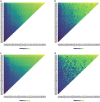Bayesian analysis and prediction of hybrid performance
- PMID: 30774704
- PMCID: PMC6366084
- DOI: 10.1186/s13007-019-0388-x
Bayesian analysis and prediction of hybrid performance
Abstract
Background: The selection of hybrids is an essential step in maize breeding. However, evaluating a large number of hybrids in field trials can be extremely costly. However, genomic models can be used to predict the expected performance of un-tested genotypes. Bayesian models offer a very flexible framework for hybrid prediction. The Bayesian methodology can be used with parametric and semi-parametric assumptions for additive and non-additive effects. Furthermore, samples from the posterior distribution of Bayesian models can be used to estimate the variance due to general and specific combining abilities even in cases where additive and non-additive effects are not mutually orthogonal. Also, the use of Bayesian models for analysis and prediction of hybrid performance has remained fairly limited.
Results: We provided an overview of Bayesian parametric and semi-parametric genomic models for prediction of agronomic traits in maize hybrids and discussed how these models can be used to decompose the genotypic variance into components due to general and specific combining ability. We applied the methodology to data from 906 single cross tropical maize hybrids derived from a convergent population. Our results show that: (1) non-additive effects make a sizable contribution to the genetic variance of grain yield; however, the relative importance of non-additive effects was much smaller for ear and plant height; (2) genomic prediction can achieve relatively high accuracy in predicting phenotypes of un-tested hybrids and in pre-screening.
Conclusions: Genomic prediction can be a useful tool in pre-screening of hybrids and could contribute to the improvement of the efficiency and efficacy of maize hybrids breeding programs. The Bayesian framework offers a great deal of flexibility in modeling hybrid performance. The methodology can be used to estimate important genetic parameters and render predictions of the expected hybrid performance as well measures of uncertainty about such predictions.
Keywords: BGLR; Bayesian models; Convergent populations; Dominance; Epistasis; Genomic prediction; Hybrid prediction; Nitrogen; Non-additive effects; RKHS; Semi-parametric models; Specific combining ability; Stress; Tropical maize.
Figures








References
LinkOut - more resources
Full Text Sources
Molecular Biology Databases

